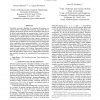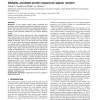122 search results - page 12 / 25 » Protein Fold Recognition using Residue-Based Alignments of S... |
ICASSP
2011
IEEE
12 years 11 months ago
2011
IEEE
TurboFold, an iterative algorithm for estimating the common secondary structures of multiple RNA homologs, is presented. The algorithm is motivated by and has structure and attrib...
BMCBI
2007
13 years 7 months ago
2007
Background: Design of protein structure comparison algorithm is an important research issue, having far reaching implications. In this article, we describe a protein structure com...
BIOINFORMATICS
2010
13 years 7 months ago
2010
Motivation: To test whether protein folding constraints and secondary structure sequence preferences significantly reduce the space of amino acid words in proteins, we compared th...
BMCBI
2007
2007
Application of amino acid occurrence for discriminating different folding types of globular proteins
13 years 7 months ago
Background: Predicting the three-dimensional structure of a protein from its amino acid sequence is a long-standing goal in computational/molecular biology. The discrimination of ...
CIBCB
2005
IEEE
14 years 1 months ago
2005
IEEE
— Part of the challenge of modeling protein sequences is their discrete nature. Many of the most powerful statistical and learning techniques are applicable to points in a Euclid...


